Did we Westerners — at some point, back in the dim & distant — become too ‘timid‘ about our food? When did we start shying away from ordering anything to eat that may still be too recognisably the original, whether animal, vegetable or mineral. When and why did we get so fucking prissily picky about things? Most especially when these textures and foods are seen as “challenging”, “foreign” or somehow just plain “wrong”?
An attitude, as I’m sure you’ll know, that’s not nearly so prevalent in the rest of the world…
The Japanese have their concept of washoku…
[pdf-embedder url=”https://salutethepig.com/wp-content/uploads/2021/11/Traditional-Dietary-Cultures-of-the-Japanese.pdf” title=”Traditional Dietary Cultures of the Japanese”]
…and there’s also a long history of eating whatever is available, on land or sea (after finding out how to stop whatever it is from actually poisoning the eater). The incredibly nutritious & gut-health affirming food called natto is an obvious example of a common dish eaten there that, to a lot of Western noses is both offensively smelly and dubiously gloopy. I must admit it wasn’t a huge favourite of mine when eating breakfast over there, but I carried on.
The Chinese have been described as
Brutally omnivorous as they consume anything that runs, walks, crawls on the ground, flies in the sky or swims in the water.
This via an American ‘diplomat’, Edmund Roberts, back in 1832, and he obviously hated (or despised) them for it — unlike my own deep admiration for the “waste not, want not” philosophy (rather than any macho bullshit about being a daring or courageous eater) — ascribing
fallen and cruel customs
to the Cantonese he was mixing with. That he deliberately chose to use the word “fallen”, with its Christian religious connotations is, I think, very significant.
Is it a religion thing for us then? I’m pretty sure that this lunacy has a lot to do with the weird taboos and strictures that are part of the Xian nations’ psyche still. I’ve just bought this book, “Unmentionable Cuisine” by Calvin W. Schwabe, described as “an engaging look at “food prejudices,” or why we eat what we eat and why we reject other food sources as unpalatable–with recipes”, which I’m hoping will help give me some more insight into this…
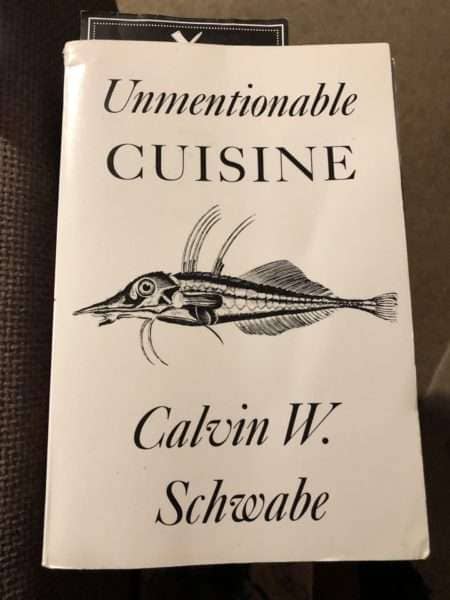
One side-bar here:
I’m impressed by the flexibility embodied in the Jewish concept of “safe treyf”, which I first came across in Ann Hui’s “Chop Suey Nation” book below, where there’s kosher food that is technically unclean but actually OK in Chinese dishes because, as Andrew Coe (op cit.) explains:
A pork chop was still forbidden, but pork chop suey was okay, because the meat was sliced into little pieces and hidden under a mound of sauce-drenched vegetables. (There’s definitely a streak of humor running through the concept of safe treyf.) Though almost always flavored with ham, Chinese soups were also permitted, because the pork was invisible. As for the shrimp and lobster? Somehow serving them in a Chinese restaurant converted them into acceptable foods, perhaps because the cooks and waiters were both non-Christian and even more alien in America than Jews.
Back to China: a far more understanding & sympathetic American — albeit writing 100 years later — Eugene Anderson, an anthropology professor, said in his 1988 book The Food of China wrote that
Chinese people’s appetites have been guided by pragmatism and eternal flexibility
believing that their relative lack of food taboos — especially because there is/was no concept in Taoism or Confucianism that any “bad” things they did in the here and now would lead to Hell or eternal damnation — has in effect given China’s cooks carte blanche to adopt far richer, more wide ranging and diverse sources of ingredients, at the same time helping to preserve social order as well as — not insignificantly — helping to
feed the world’s most populous nation over the long term
It’s a stunning, exemplary achievement by the Chinese, to have worked out how to feed their people, numbering close to a quarter of the world’s population, whilst still using only 7% of the world’s cultivated land-mass and — at the same time — developing possibly the most complex and renowned cuisine in the world. Scholar and archaeologist Kwang-chih Chang agrees¹, saying
Chinese people are especially preoccupied with food
&
food is at the centre of, or at least it accompanies or symbolises, many social interactions
Going on to say that, over the course of Chinese history:
continuity vastly outweighs change
Of course, China’s history of fellow peasants dying from lack of food, is so very fresh in their memories, the last major one occurring as recently as 1959-1961 in the horror known as the “Great Leap Forward Famine”, quite possibly remaining as still the largest famine in human history…
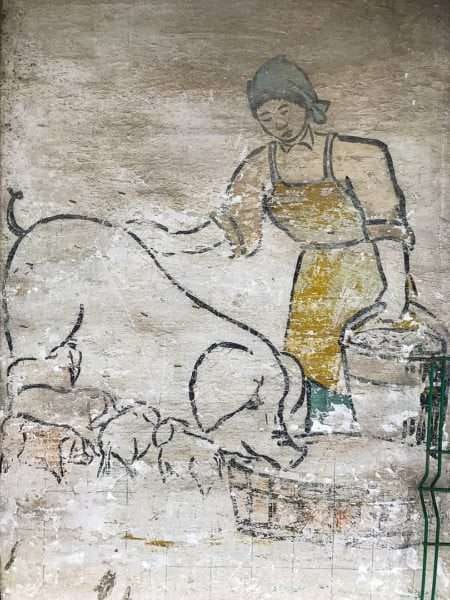
© Fayhoo, CC BY-SA 3.0 via Wikimedia Commons
Similarly in Japan, in the radioactive, bombing-stunned aftermath of WWII, the Allied occupation forces imposed strictures, meant huge food scarcity and a further accretion onto their already heavily laden race memory, that meant that wasting any food or any food source was both abhorrent and, frankly, stupid. I’m reading this book currently on how Japan sees the countryside as a larder, a place of bounty as well as — thanks partly to Shintoism — a thing of deep & wondrous beauty; it’s a great read…

… and it reminds me of the description of Flatt’s in Noto, Japan, by Matt Goulding in his “Rice, Noodle Fish”
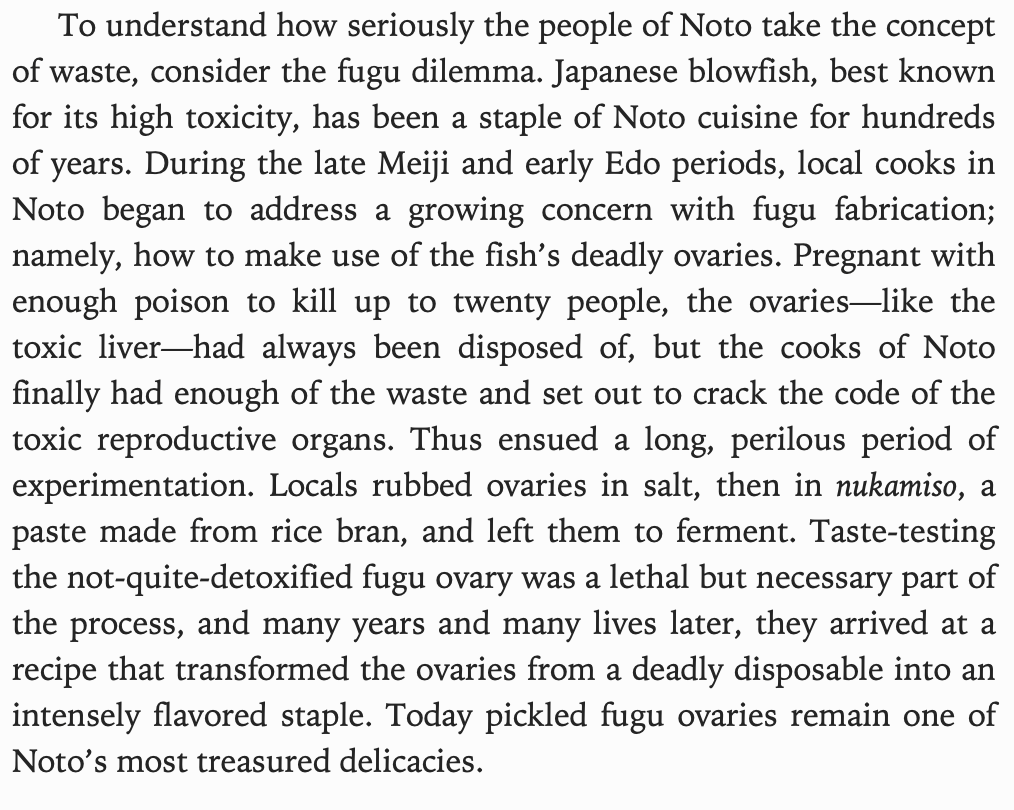
I then came across the name Lin Yutang (林語堂), whilst reading…

…a fascinating 20th. century polymath, variously described as “inventor*, linguist, novelist, philosopher, and translator.
[* he even patented a Chinese language mechanical typewriter for fuck’s sake.]…

… who wrote:
China has too large a population… famines have come much too often. To survive, one is obliged to eat everything that can be held between the fingers.
[Interestingly, his wife, Liao Tsui-feng (廖翠鳳), was also an author and one who, along with their daughter Lin Hsiang Ju, wrote three cookery books inc. Chinese Gastronomy (1955), later re-titled as The Art of Chinese Cuisine, all of which were hugely influential in popularising Chinese food in the English speaking world.]
Is it then that we in the rich West, have no real memory of famine or having to be prepared for it or what’s needed to survive? Certainly in England, we’ve not seen any such nationwide hunger since the early 17th Century, so maybe that’s a part of it. Except, and I have no answer to this implied question, other countries such as India have suffered equally terrible famines and yet they appear to have less of an omnivorous palate than their Asian neighbours?
Back in the Western hemisphere, our moral panic rises when it’s suggested that we look at eating animal breeds that we might have fond feelings for? I mean, no one seems to give a shit about the actual contents of those chicken nuggets they scarf down or how they’ve been treated in their short, brutish lives, but mention rabbits, deer, pigs, horses, dogs? Get away man! There’s a soft-spot in their psyche on this idea, one that they’ll rapidly lurch away from, just as they’d shy away from any plate containing them.
Please do as much as you can therefore, not to remind us that the food placed in front of us might once have lived, breathed, swum, walked (or, in the case of Bambi, gambolled) or simply popped up from under the ground. No extremities or appendages (noodley ones aside), thus ruling out feet, claws, tongues — and don’t even talk to us about ears — unless very well disguised. And, we beg you, beg you, nothing with fucking eyeballs. (And yet still many of us still seem to love offal? Classic peasant food in times of scarcity.)
Next, we need to talk to you about opacity. We shouldn’t able to see the fucking table through our fucking food! Remember then, nothing transparent, not even translucent, which for sure kills off all thoughts of jellyfish or octopus and also eliminates certain kinds of ‘delicious’ fungus from any dinner plate.
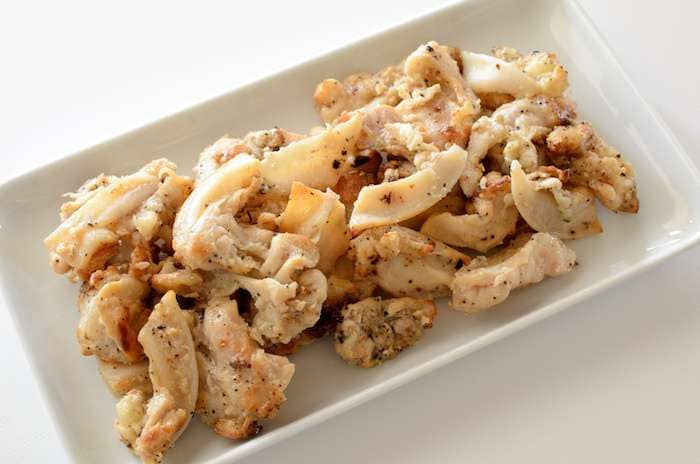
Fried chicken cartilage ©Japan Info
We also seem to have some very strict boundaries on the textures that we will allow to have congress with our mouths: nothing gelatinously rubbery for example, so out of the window goes anything like tripe and obviously those sea cucumbers are strictly déclassé & off the menu. And if anyone even mentions the idea of chewing on fucking lungs? What kind of sick fuck are you people, anyway?
Anything that’s too crunchy — pork scratchings aside — will be a problem, did we mention that too? So don’t you be trying to pass off any cartilage or connective tissues onto our plates, no Sirreee. And please remember that there’s an acceptable and an unacceptable range of colours that we’ll accept. Nothing organic should be too black, so you can think twice about serving up anything like seaweed or those weird, disconcertingly black, mushrooms and, at the opposite end of the palette spectrum, nothing made with flour should be too anaemically white. I’m afraid those steamed bao buns have the weirdly under-done look of a Ghostbusters’ Stay-Puft Marshmallow Man; that’s not right, toasted brown is much healthier looking.
And note, anything that goes into our mouths should never then come back out. So, let’s not serve anything from which you may after chowing down on the rest of it, then have to hawk out some inedible part. This means no fish with bones, no ‘kneecap’-like bits off chicken legs, no chicken feet, no unshelled peanuts, get rid of those seeds from that melon first and no shrimp that arrive still contained in their shells.
To be honest, I’m not sure how you lot even cope with fucking chicken wings, but hey!
In so many other countries though, this detritus remaining after a restaurant meal, those piles of shells, bones and other debris dropped carelessly on the table or onto the ground, at everyones’ place setting, are simply the proud casualties in the very personal war that’s just been waged between diner and dinner. We lived and worked in Spain for a number of years and the multi-generational Spanish Sunday lunches in the beachside chiringuitos were an amazing cacophony of talking, shouting, biting, crunching, laughing, spitting & dumping. And that was just their grand-kids…
Remember: the Spanish — and all other sensible nations — buy, cook and serve their fish whole.
It should look like this. Simple as that.
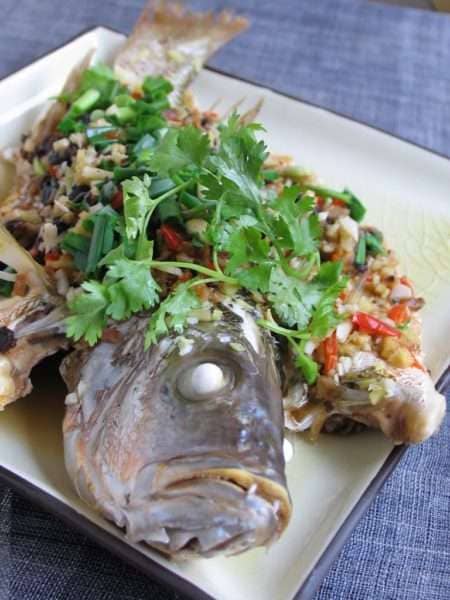
To finish off, at least for today, I give you “Roll Another Number (for the Road)” by Neil Young. Absolutely nothing to do with food. Or China. Or famine. Or anything I’ve written about above. And in addition, Val dislikes his ‘nasal whining’.
Me? I’ve always loved this Canadian lad. I first saw him singing this one way back in November, 1973, at The Rainbow (scene of sooooo many happily stoned nights for me), on his “Tonight’s The Night” tour. Weird, fucked up vibes, straggly mock palm trees at the back of the stage, Nils Lofgren quietly genius on guitar, Neil, dressed in a long raincoat, dragging cassette tapes out of his pocket, rambling at some points, at others angry, savage, scary, a hoary counter-point to his own balmy hippy Harvest days, with the recent OD deaths of Danny Whitten and roadie Bruce Berry, fully front & centre. One of the very best of any of the spine-tingling music nights I’ve ever seen.
¹. Chang Kwang-chih (ed.) Food in Chinese Culture: Anthropological and Historical Perspectives, pp. 15–20. Yale Univ. Press (New Haven), 1977.